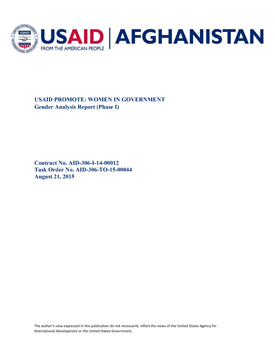Historically, women have been extremely underrepresented in the Afghan government, and as a result, they have had limited ability to shape policies and programs that directly affect them.

Women in Government Gender Analysis Report .
Project Report | August 21, 2020

To support the PROMOTE: Women in Government objectives, the project conducted a gender analysis to analyze the status of men and women as related to project activities and how local gender norms will shape project design and implementation, and opportunities for male engagement.
PROMOTE is a joint commitment by the United States and Afghan Governments that works to empower 75,000 women between the ages of 18 and 30, and help ensure these women are included among a new generation of Afghan political, business, and civil society leaders. To support the project’s objectives, in July and August 2015, the project conducted a gender analysis in tandem with a partnership assessment to analyze the status of men and women as related to project activities and how local gender norms will shape project design and implementation, and opportunities for male engagement. The findings of this assessment revealed detailed information about the structural as well as cultural challenges faced by women trying to enter government. Perhaps not surprisingly, both female and male interviewees noted that security issues and the distance between home and work were two of the biggest perceived challenges faced by women. However the analysis process also revealed some interesting gender gaps on how men and women perceive other types of challenges – for example males noted more concern about close working quarters and the lack of bathrooms than the females, and conversely females noted more concern about the lack of available office equipment as challenge than the male respondents. The sex-disaggregated information was then used to shape the recommendations to overcome the perceived challenges for women working in government. The resulting recommendations center on how to ensure that existing project activities are designed and implemented in a way that addresses the differing ways in which women and men perceive women working in government.
